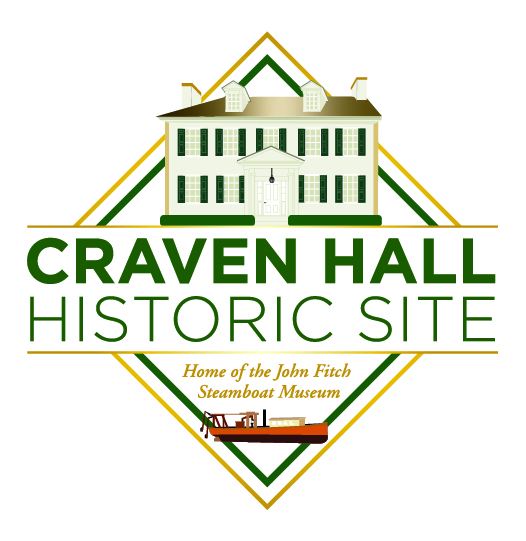About Craven Hall
The History
The land on which Craven Hall sits today was part of a 551-acre land grant from William Penn to William Bingley in 1681. Within the next 45 years, William Stockdale acquired the land and in 1726 sold 151 acres to James (Jacobus) Craven. The land remained in the Craven Family until the death of Giles Craven in 1798. Giles, before his death, arranged the sale of the property to a kin, Harman Vansant (Alice Craven was his grandmother) and the property remained in the Vansant Family until 1871.
The exact date of the initial construction of Craven Hall is unknown but architectural detail and tax records would indicate a period between 1790 and 1815. The main wing added later and facing Newtown Road is detailed in an 1845 fire insurance policy.
The last surviving Vansant (Ann Eliza) sold the property to another kin, Issac Bennett, and the Bennett family lived there until 1923. During the 1940’s, The Lojeske Family had a commercial vegetable operation on the property and the house served as a residence for three families, including two Japanese/American families released from an interment camp in Arizona after World War II.
In 1952, the Centennial Joint School Board Authority purchased 70.6 acres to build a high school on the land that included Craven Hall and the burying ground.
During the school authority’s ownership, Craven Hall was used as a junior high school and then as administrative offices for the school system. The house deteriorated and became uninhabitable in the mid-1970s and was abandoned.
In 1979, The Centennial School Board agreed to lease Craven Hall to a non-profit group under the leadership of Ella Rhodes, a retired Social Studies teacher. The Citizens for the Preservation of Craven Hall, Inc. received a lease on the condition that the building would be returned to habitable condition with the replacement of the roof.
Restoration efforts began immediately after the lease agreement and continued on for 26 years until 2005, most of the restoration accomplished by volunteers.
In 1993, the then owners of the property, Schaefer Builders of Southampton, PA deeded a one- acre parcel of the property to the Society who adopted Craven Hall Historical Society, Inc as their new name. Subsequently, a small portion on the South end of the property was taken by the local water authority for access to a water tower.
The Craven Hall Historical Society, Inc. is a private 501-C3 non-profit corporation and owns Craven Hall, The John Fitch Steamboat Museum (an adjacent building) and the Craven/Vansant Burying Ground located between the Fox Run Apartments and the Tall Oaks development. Access to the site is from the Fox Run Apartments.
Updated December, 2020


The Vansant Family
The building known today as Craven Hall was so named in the early 1950’s by the then principal of William Tennant High School, W Thomas Vaughn when the building was converted for use as classrooms. He added the word “Hall” to Craven to better reflect the structure as a school facility.
Craven Hall and the surrounding acreage was known from 1798 till 1871 as the Vansant Farm and the Vansant family reflect the major ownership of the property and deserve a record of their history with the property.
Harmon Vansant, patriarch of the family, was born in 1757 and died in 1823. He served in the Bucks County Militia during the Revolutionary War and continued his military service in the militia until his death, achieving the rank of Brigadier General. He was an active recruiter during the war of 1812.
Harmon was married to Alice Hoagland and had a son, James and three daughters, Jane, Alice, and Ann Eliza. He was listed in the census records as both a farmer and distiller and was a prominent citizen in Bucks County. He is recorded as the first Director of the Poor House (today’s Neshaminy Manor) in 1810.
Harmon’s wife and son died shortly after him and the property remained in family owned for over 40 years by two spinster sisters, first Alice and then Ann Eliza. The wealth of the family at the time of the death of Ann Eliza in 1871 is reflected in her will that left over $25,000 (approximately $450,000 in today’s dollars) plus considerable acreage and personal possessions.
What isn’t clear is when and who accomplished the exquisite Greek Revival detailing of the main wing of the building that is the main basis for our inclusion on the National Register of Historic Places. Greek Revival architecture was just beginning to gain popularity at the time of Harmon’s death. Did the mother or two sisters commission the work? We may never know but we keep searching.
The interment of all the family members in the cemetery belonging to the North and Southampton Reformed Church off Bristol Road in Churchville, PA is another unsolved mystery. Why were they not interred in their own graveyard?
Updated December, 2020


Museum Template – Mad UX © 2018. All Rights Reserved

